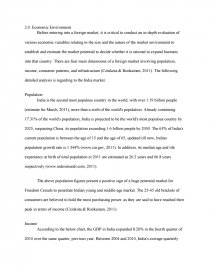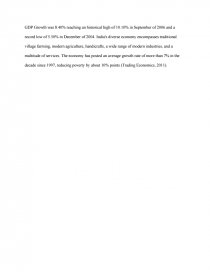Nike Sweapshop - Before Entering into a Foreign Market
Essay by Zomby • August 18, 2011 • Essay • 343 Words (2 Pages) • 2,263 Views
Essay Preview: Nike Sweapshop - Before Entering into a Foreign Market
2.0. Economic Environment
Before entering into a foreign market, it is critical to conduct an in-depth evaluation of various economic variables relating to the size and the nature of the market environment to establish and estimate the market potential to decide whether it is rational to expand business into that country. There are four main dimensions of a foreign market involving population, income, consumer patterns, and infrastructure (Czinkota & Ronkainen, 2011). The following detailed analysis is regarding to the India market.
Population
India is the second most populous country in the world, with over 1.19 billion people (estimate for March, 2011), more than a sixth of the world's population. Already containing 17.31% of the world's population, India is projected to be the world's most populous country by 2025, surpassing China, its population exceeding 1.6 billion people by 2050. The 65% of India's current population is between the age of 15 and the age of 65; updated till now, Indian population growth rate is 1.344% (www.cia.gov, 2011). In addition, its median age and life expectancy at birth of total population in 2011 are estimated as 26.2 years and 66.8 years respectively (www.indexmundi.com, 2011).
The above population figures present a positive sign of a huge potential market for Freedom Cereals to penetrate Indian young and middle-age market. The 25-45 old brackets of consumers are believed to hold the most purchasing power, as they are said to have reached their peak in terms of income (Czinkota & Ronkainen, 2011).
Income
According to the below chart, the GDP in India expanded 8.20% in the fourth quarter of 2010 over the same quarter, previous year. Between 2004 and 2010, India's average quarterly GDP Growth was 8.40% reaching an historical high of 10.10% in September of 2006 and a record low of 5.50% in December of 2004. India's diverse economy encompasses traditional village farming, modern agriculture, handicrafts, a wide range of modern industries, and a multitude of services. The economy has posted an average growth rate of more than 7% in the decade since 1997, reducing poverty by about 10% points (Trading Economics, 2011).
...
...

